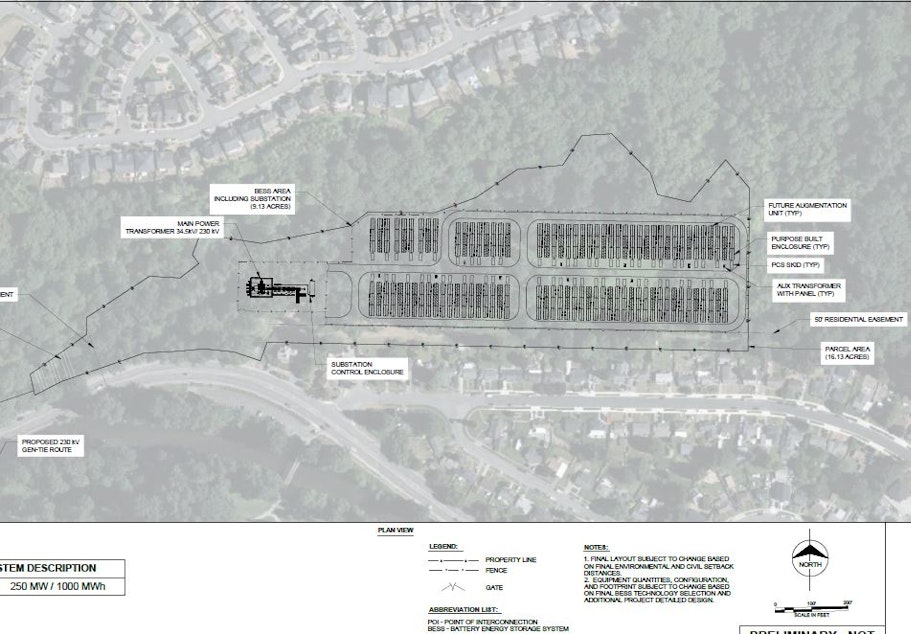Renton neighbors object to storing climate-friendly batteries in their community

Turning away from fossil fuels is the central challenge for saving the global climate.
Drawing more energy from clean sources is only one part of the puzzle. So is storing that energy for when the sun isn’t shining or the wind isn’t blowing.
Just south of Seattle, a proposal for an industrial-scale energy storage facility has neighbors crying foul.
Omaha-based Tenaska, one of the nation's largest privately held companies, wants to cover nine acres of undeveloped land in Renton with banks of lithium batteries. The facility could discharge 250 megawatts of power — about the output of a large coal-burning power plant, or one-tenth the typical power provided by Puget Sound Energy, the state’s largest utility — for four hours at a time.
“That’s really big,” said activist Fred Heutte with the nonprofit Northwest Energy Coalition.
“There were hardly any five years ago,” Heuette said of the big energy storage centers. “And now we're seeing very large ones being put in all around the world.”
Energy experts say people should expect a lot more energy storage to be built as the world shifts from dirty power to clean.
In a letter to city officials, Tenaska wrote the $250 million project will position Renton as a leader in Washington’s fight for a carbon-free future and increase the resiliency of the electrical grid.
Sponsored
But neighbors living 50 feet away are crying foul.
“We do believe in green energy, but not if it threatens communities, families, the environment, wildlife, and our waterways,” said Nicola Robinson, a nurse, during a Renton City Council meeting on Monday.
In April, the city put a six-month moratorium on battery storage proposals while it figures out where they can be installed safely and legally.
The city’s land-use code currently lacks a category for energy storage.
The mostly wooded land Tenaska wants to pack with lithium batteries is zoned for “resource conservation,” a designation that in Renton allows for only “very low-density residential uses.”
Sponsored
Opponents extolled the land’s value as wildlife habitat while Tenaska’s proposal says it’s mostly covered by invasive Himalayan blackberries.
Tenaska’s proposal shows houses sitting 50 feet from the facility’s south side. Neighbor Lori Goeman said she was baffled.
“It is not zoned for this type of thing, so how can this even be considered?” she said.
“Steer them in a different location where it’s not close to a community,” Goeman told the council.
The Renton Planning Commission is scheduled to hold a hearing on the proposal on July 20, then make its recommendation to the city council.
Sponsored
Lithium batteries have no moving parts, and their use produces no air or water pollution. But they have a history of sometimes overheating or catching fire.
It’s why the Federal Aviation Administration prohibits spare or uninstalled lithium batteries in checked baggage.
Lithium-battery plants in Arizona and California have caught fire and even exploded in recent years.
Nine first responders in a Phoenix suburb were injured when a 2-megawatt battery storage facility they were trying to extinguish exploded in 2019.
In April 2022, a 10-megawatt battery storage facility in a different Phoenix suburb caught fire. Firefighters sent robots to open the doors. Then they let the facility air out for a day to let any hazardous gases dissipate before entering the building.
Sponsored
The proposed Renton facility would “include built-in fail-safes and multi-layered fire protection features designed to prevent thermal runaway and the spread of fire,” according to Tenaska’s proposal.
Seattle energy-storage consultant Russ Weed, who is not connected to the Renton project, said the industry has been spending significant time and money to lower the risk of lithium-battery fires.
“If we want to all have EVs, we're going to have to have storage,” Weed said.
“Say they're charging at home,” he said. “If everyone's hitting their distribution system at home between 7 and 10 p.m. because people get home and plug in, that's going to stress out the grid. So you need storage to deal with that.”
Heuette said the Northwest Energy Coalition advocates for clean energy but does not take positions on individual projects.
Sponsored
“We see a real need for these kinds of storage resources,” Heuette said. “It doesn’t mean they have to be in everybody’s neighborhood.”
Energy storage can be added at various points along an electrical grid, including existing electrical substations or power plants.
The Wheatridge Renewable Energy Facility in northeastern Oregon started operating in March with a combination of wind turbines, solar panels, and 30 megawatts of battery storage on site.




